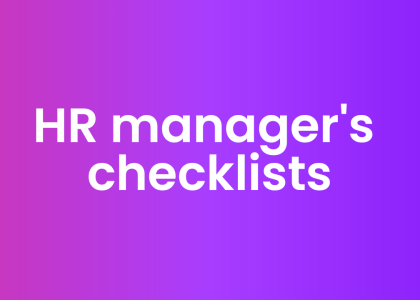Self-service HR checklist
Enabling self-service can take a huge burden off your HR team’s shoulders. Follow these tips to see where you could add more options to empower your people and give your HR team more to work with.
1. How easy is it for an employee to ask a question?
There are many mundane questions an employee might ask the HR team. From how much PTO they accrue, to raise eligibility, to queries about policy. Some of these need the human touch, but many could be answered by a chatbot or centralised policy hub.
2. How do your employees book holidays?
Does HR need to get involved? Is it handled on a spreadsheet? Through emails? What’s done if there’s a clash? Clarity on this can save a lot of issues down the line.
3. What support systems are in place for employees?
Most people see HR as a place you get sent to, but HR can also be a tool for employee support. How do employees access your employee assistance programme?
4. Are you still using timesheets?
Many organisations are seeing the value of letting employees clock-in online, instead of filling in manual timesheets. This is especially useful if you have a hybrid or decentralised workforce.
5. What learning strategy do you have in place?
HR teams often have to juggle a learning strategy on top of their other responsibilities. Do you have any systems in place to help them manage this? Do employees need to ask to be put on any training course, or is there content they can partake in at any time?
6. How do you gauge engagement?
Do you run regular appraisals or check-ins? Do you have access to analytical tools, and how much data literacy is needed to utilise them fully?
7. How do you communicate with employees?
Do you have a central platform where changes and policies are communicated, or does it depend? Is there consistency to your approach, and are you certain that everyone’s getting the message?
For a smarter, consistent approach to HR, take a look at People First, it's packed with ESS features that empower your workforce and free your HR team from an abundance of admin.
Recruitment checklist
Candidates want a recruitment experience that moves quickly and treats them with respect. This seven step checklist is your way to a faster, smoother recruitment process that attracts great candidates.
1. Are your job descriptions working?
Ensure job descriptions are clear in the role responsibilities and expectations. Keep them concise and lead with what’s most important.
Did you know: job descriptions under 300 words get 8.4% more responses?
2. Are your application forms concise?
Candidates hate having to tell you the same information over and over again. Design your application forms with the end user in mind,
Did you know: 60% of job seekers abandon application forms due to length and complexity?
3. Are you screening applicants?
Set up screening questions so that anyone inappropriate for the role, such as not having the right skills, is removed from the process.
Did you know: 46% of newly hired employees will not succeed in their new roles within 19 months? Screening is vital!
4. Are you automating what you can?
Much of the hiring process can be automated. For example, automation can speed up how quickly you screen applicants, or get in touch with unsuccessful candidates.
Did you know: using AI in recruitment can reduce the average cost of hiring a candidate by 71%?
5. Are you getting in touch with the candidate before the interview?
For example, you can let them know who they’ll be talking to, what the interview was looking like, even little things like what tests they might be given.
Did you know: 48% of candidates respond positively to receiving interview information ahead of time?
6: And how about after?
A simple message to let a candidate know they’ve not been successful can take the sting out. This can be automated, but if you can give them specific feedback that’s even better.
Did you know: just 17% of candidates receive feedback after being rejected?
7: Are your managers trained to handle interviews?
Ensure that hiring managers are prepared for their interviews. A large number of candidates withdraw from a process where they had a bad experience with a manager who was not prepared for an interview. Also, ensure each candidate is given feedback.
Did you know: 48% of candidates are deterred from applying for jobs after poor first impressions?
The right tech can be the key to an organised and effective recruitment process. Learn more about People First Recruitment.
Employee engagement checklist
Highly engaged teams have a 43% lower turnover rate than low engaged teams, so it’s critical to get the right processes in place.
Here’s our top 10 tips to help you make the most of your engagement strategy.
1. Do you have a clear vision?
What should employees be involved with? What are the company values? What culture do you want to create? How will you measure employee interactions?
2. Do you share your goals with the team?
Will they benefit? Why should they care? Be consistent and use a platform that everyone has access to. If there are changes, make people aware.
3. Do you invest in your leaders?
Consider what soft skills training might be required to support managers. Create visibility around what leaders are planning and show adherence to company values.
4. Are your company values meaningful?
For example, if sustainability is a value, communicate where waste can be reduced, encourage recycling, discourage printing and consider cycle to work or car share schemes.
5. Are you hearing your employees?
Listen to employees and provide them with a voice that can contribute towards change. Survey what they love and what frustrates them within their role and the wider organisation.
6. Is your culture built on trust?
Clearly set expectations. Encourage open communication, collaboration and invite idea sharing. Ensure leaders share the roadmap for the company’s growth. Don’t be afraid to communicate around sensitive subjects – address them openly.
7. Are you giving regular feedback?
Check-ins provide consistent, regular catch-ups between managers and employees to discuss performance, progress and development.
8. Do employees know you care?
Whether that’s through a formal ‘employee of the month’ award scheme, or simply thanking teams for a job well done, it’s important to ensure everyone feels valued for their time and effort.
9. Are you celebrating wins - large and small?
Whether that’s publicly or just a quick email to say well done, it’s important to give credit where it’s due and should be encouraged between colleagues as well as leaders.
10. Do you have the right digital tools in place?
Invest in technologies that allow employees to collaborate and communicate, as well as keep in touch with company news, whether they’re remote or in the office. Consider training, learning, and achievement sharing as part of your requirements.
For more details on how to boost employee engagement, check out our guide on 10 ways to improve employee experience with People First.
Reverse mentoring checklist
Reverse mentoring pairs younger employees with more senior employees to help exchange knowledge.
Here's 10 questions to address when creating a reverse mentoring scheme:
1. Do you know what problems you’re trying to solve?
Are you trying to bridge certain skills gaps? Are you trying to initiate a greater culture change? How will you measure the success of your reverse mentoring programme?
2. Have you marketed the initiative internally?
Communicate the benefits, expectations and commitment required for the programme. Consider where and when these communications will be shared so your whole workforce has time to apply.
3. Do employees have to apply or can people be nominated?
How will you ensure a balance of younger and senior employees are involved? Ensure you are collecting the right information to match partners, such as what they hope to gain from the programme.
4. How do you match mentors and mentees?
Consider diversity, department, location and personality. Ensure both parties are consulted on their potential match before the decision is made formally.
5. What about the foundations?
Establish programme duration and standard guidelines to ensure expectations are clearly laid out, but encourage mentors and mentees to decide how often they meet, how this meeting will take place (in-person vs. remote), and how long meetings should be.
6. Have you set up a discovery session?
Create a “getting to know you” document for all the participants to fill out to support introductions, act as conversation starters, and break the ice.
7. Have you set some goals for the participants?
Ask them to highlight skills gaps or what they would like to learn as part of the programme, and set goals to create medium and long-term development plans and review periods.
8. How are you tracking things?
Ensure progress is tracked on a suitable check-ins and both mentors and mentees offer feedback throughout. By logging these meetings, both parties can revisit the check-in track progress over time, and work together on a shared path.
9. How will you evolve the programme?
Collect feedback from all participants so you can ensure the programme evolves to best support your people. A quick survey ensures all responses are collated centrally and are easy to analyse.
10. Do you know if it’s working?
If you have identified any reverse mentoring success stories, think about how you can share them internally to encourage others to join.
Next steps
If you're looking to elevate the way you work, you may find our high performance how to guide useful. Inside you'll find eight practical steps to drive high performance across your entire organisation, with hints and tips on where technology can help.



